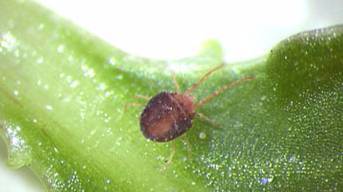Clover Mite
Bryobia praetiosa
Identification
- very tiny; about the size of a period on a typed page
- green to black, sometimes with red/orange markings/legs
- very long front legs that look like antennae
- use a hand lens to identify
Nesting Habits
- live primarily in turfgrass
Diet
- primarily turfgrass
Significance
- migrate indoors in the late spring and fall (often up the exterior sides of buildings and through windows)
- mites numbering in the hundreds or thousands can be a major nuisance
- can stain fabric when smashed
- not a health threat
IPM Recommendations
- Create a turf- and weed-free boundary around buildings 3-5 feet wide minimum.
- Within boundary, use pea-gravel or mulch to retard mites.
- Within boundary, use plants that are unattractive to clover mites, such as geranium, chrysanthemum, zinnia, marigold, salvia, rose, petunia or shrubs such as barberry, juniper and yew.
- Ensure that seals around windows are in good repair.
- Vacuum mites indoors and outdoors.
- Double-sided carpet tape can reduce numbers coming into buildings. Place tape as a barrier to building entry.
- Use supplemental irrigation in drought-stressed or hot parts of the turf to suppress mite migration.
For more information, see our Clover Mites fact sheet.




